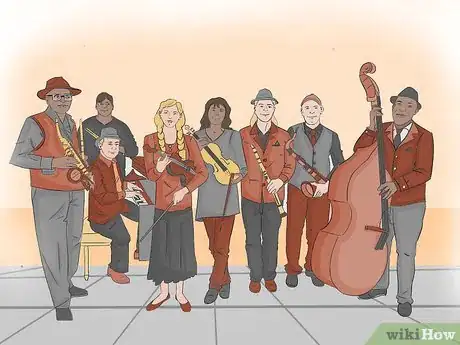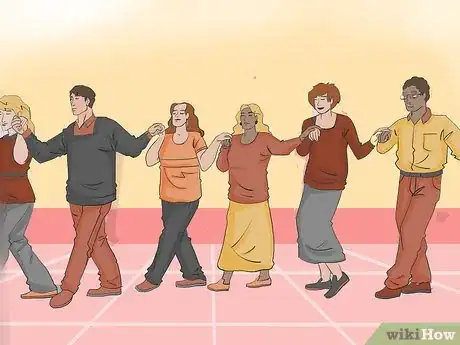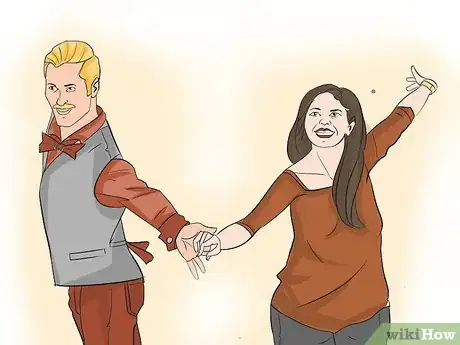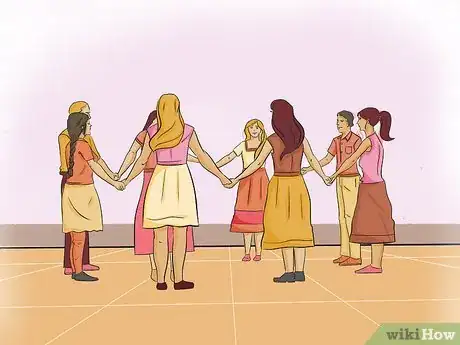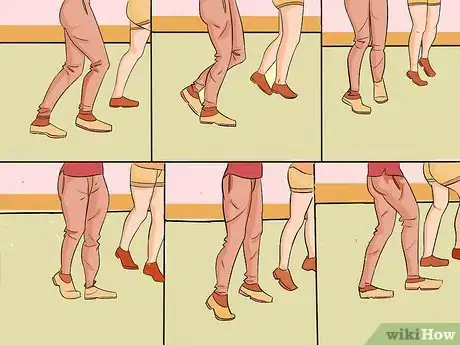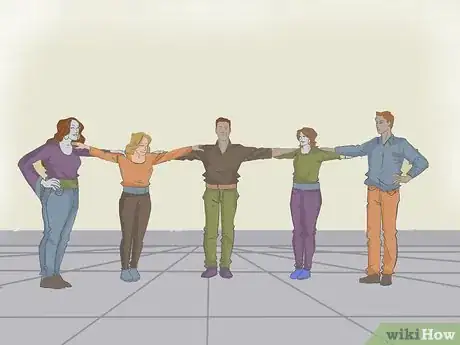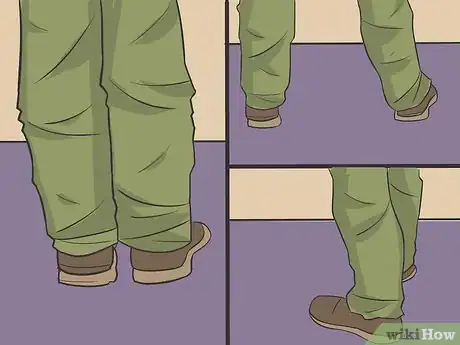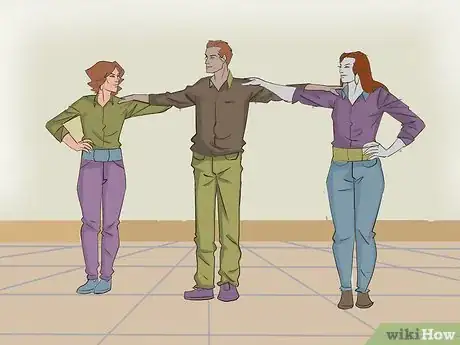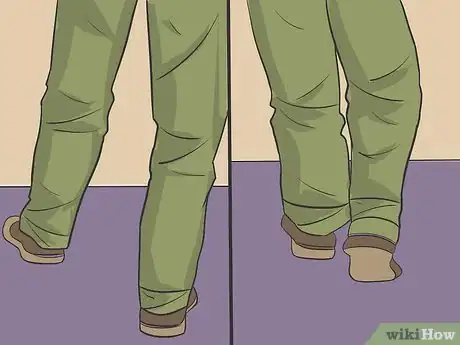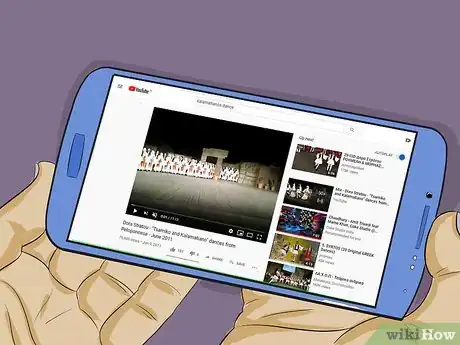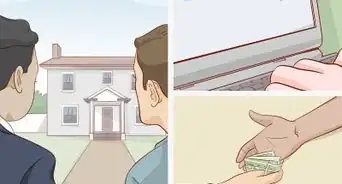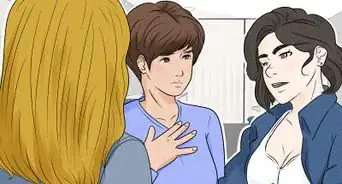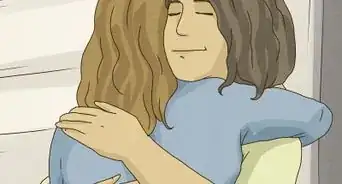This article was co-authored by Hebert Aguilar. Herbert Aguilar is a Professional Dancer, Choreographer, and the Director of Timba Heat Dance Company. With more than a decade of experience, he specializes in performing and teaching dance styles such as Cuban Salsa, Hip-Hop, and Acrobatics. Hebert has performed at a variety of venues and locations including San Francisco, Washington, Hawaii, and Miami.
There are 13 references cited in this article, which can be found at the bottom of the page.
This article has been viewed 21,249 times.
The main two types of circle dancing done at weddings are the Jewish Hora and Greek dances such as the Kalamatianos. All of these dances start with the wedding guests joining together in a circle while holding hands. Most of the dances have very simple moves, involving things like stepping across or behind one foot or kicking your foot out in front of you. Decide which kind of dance you'd like to learn, and practice the steps over and over again, using an online video to help you if needed.
Steps
Learning the Hora Steps
-
1Stand in a circle and join hands with the other dancers. If you're practicing with other people, great! Have everyone form a circle and hold hands.[1] If you're practicing by yourself, just hold your arms out to each side and pretend you're holding someone's hand to make the practice as authentic as possible.[2]
-
2Step to the left and bring your right foot back. Starting in a regular standing position, use your left foot to step to the left. After you've stepped to the left, you're going to step with your right foot by bringing it back behind the left.[3]
- Since you'll be holding other people's hands, the size of your steps may depend on the other dancers next to you.
Advertisement -
3Move to the left using your left foot again. With your right foot behind your left foot, step to the left again using your left foot. Now your body should be in a normal standing position again.[4]
- Try to use the same size step for each movement.
-
4Kick with your right foot and then your left. Kick gently with your right foot going out in front of you before putting your right foot down and kicking gently with your left foot. These kicks will be aimed in the center of the circle.[5]
- How high you kick is up to you, but it's only necessary to lift your leg a few inches off the ground.
-
5Repeat the sequence over again. After you've finished kicking with your left leg, you've learned the whole dance! Repeat the steps, stepping to the left, putting your right foot behind you, stepping left again, and doing the kicks. Practice several times until you feel confident you can do the dance.[6]
- Start by practicing at a slower pace, and then do the dance faster as you become better at the steps.
-
6Look for video tutorials online if you need guided instruction. If you want to see others doing the dance for a more visual representation, view YouTube videos like this one: https://www.youtube.com/watch?v=pGTho2a9t9k. By typing "Hora dance tutorial into the search bar, you'll find lots of videos that will help you learn the steps.
- Play the videos as many times as necessary, watching the dancers' feet carefully to ensure you're learning the right steps.
Performing the Hora at a Wedding
-
1Listen for klezmer music. This is the traditional music that’s played during the Hora dance. If you’re planning the wedding, ask your band to play klezmer music for you and your guests to dance to, or make a playlist of songs to give to your DJ. If you’re a guest, wait for the newlyweds to begin dancing and then join in.[7]
- For examples of popular song choices, go to YouTube and type “klezmer wedding songs” into the search bar.
-
2Look to the Hora dance leader if there is one. Sometimes there’s a Hora dance leader who’s hired to get the guests up and moving and show them what to do if necessary. If someone wasn’t hired, a family member or friend might be the leader. If you’re not certain exactly when to start or what to do, look to those around you for guidance.[8]
-
3Stand in a circle and join hands with the guests. Once you notice the klezmer music starting and the possible Hora dance leader getting everyone excited to dance, come to the dance floor. Form a circle with the other guests and hold two other dancer's hands.[9]
- If the dance floor is small, it may be necessary to form several rings of circles so everyone gets to dance.
-
4Perform the practiced Hora steps. Do the steps just as you practiced, stepping left, right foot back, stepping left, and kicking both feet. Continue the moves over and over again, moving to the beat. If you get lost or stuck, look to the person next to you for guidance.[10]
-
5Lift the couple into the air on chairs. One of the most exciting parts of the Hora is having the couple sit on chairs and lifting them up into the air. If you’re feeling strong, join in with the other guests who are lifting up the chair. Gently move the chair up and down in a bobbing motion, making sure to keep the couple balanced.[11]
- Sometimes the couple will be thrown up into the air on sheets instead of chairs, as per tradition.
- The couple often holds on to each end of a handkerchief as they’re lifted into the air.
-
6Avoid worrying about making mistakes. Don’t worry if you make a wrong move or two. A major part of the Hora, and the wedding reception in general, is to have a great time.[12] If you make a mistake, just keep moving, put on a smile, and have fun.[13]
- If you get thrown off, look to the person next to you to get back to tempo.
Learning Simple Greek Circle Dances
-
1Form a circle with the guests while holding hands. When it’s time to circle dance, grab hands with the person next to you to join in the circle that’s made on the dance floor. If there are a lot of guests, there might be several rings of circles so everyone can dance.[14]
-
2Dance the Sirtaki for a simple dance. In this dance, you use your left foot to step across your right foot first, then step with your right foot so you’re standing evenly again. Give a light kick with your left foot, a kick with your right foot, and then start the steps all over again.[15]
- Move to the tempo of the music, following the speed of the others next to you.
-
3Try adding your own flair to Zeibekiko steps. While Zeibekiko allows lots of interpretation, there is a basic step that will get you started. Starting with your right foot, cross your left foot in front of the right. Step to the right, then cross the left foot in front again. Step right, then step back with your left foot, pick your right foot up off the ground, and repeat the process over again.[16]
- Zeibekiko is a Greek dance that doesn’t have concrete steps that all dancers must follow, and instead encourages dancers to let the song speak to them.
- Add your own personal style to this movement, improvising if desired.
- In this dance, it’s common for one person to be in the middle of the circle doing their own movement while the dancers in the circle clap.
-
4Show off your dance moves by doing the Tsamiko. Step to the right with the right foot, step across with the left, step with the right, step across with the left, step with the right, step across with the left, step with the right, and then lift your left foot off the ground. Now step to the left with the left foot, cross with the right, step with the left, and lift your right foot up towards the center of the circle.[17]
- Sometimes people add their own squats or leaps into the dance depending on the rhythm.[18]
- For visual help to learn this dance, go online and type “Tsamiko dance tutorial” into a search engine.
-
5Practice each dance until you feel confident you know it. While each dance has similar steps, they will all take practice to learn and become great at. Don't worry if it takes you several attempts to get the hang of the dance, and remember to have fun while you're doing them!
Performing the Greek Kalamatianos
-
1Come together in a circle while joining hands. The Kalamatianos is a 12-step dance that's performed in a group. Join hands with other dancers and form a circle so you're ready to start dancing.[19]
- The circle will move counterclockwise.
- The 12 steps will be repeated over and over again throughout the dance.
-
2Step with the right foot before putting the left foot behind the right. Starting in a normal standing position, step to the right with your right foot. Now step using your left foot by placing it behind your right foot.[20]
- It's best to take small steps instead of large ones when you're first learning the dance.
-
3Move to the right again and put your left foot in front of the right. With your left foot now behind your right foot, step to the right again with your right foot so that you're in a regular standing position again. Now step with your left foot, bringing it across your right foot instead of behind this time.[21]
- Don't worry about making large strides when you're putting one foot behind or in front of the other.
-
4Square your shoulders while stepping with the right foot. Step to the right again with your right foot. Try to situate your body so that you're facing the middle of the circle. Your feet should be in a normal standing position now.[22]
-
5Cross behind the right foot before stepping forward on the right. Use your left foot to cross behind the right foot with a single step. Now step forward on your right foot.[23]
- The step forward onto your right foot will be more of a shifting of weight from your left foot to your right.
-
6Step to the left before crossing your right foot behind the left foot. Use your left foot to step left. Bring your right foot behind you, crossing behind the left foot with one step.[24]
- Don't worry if you're not facing the center of the circle at this point.
-
7Move forward onto the left foot, and repeat the steps. Step forward using your left foot, and you've finished the 12 steps! Repeat each step, going slowly until you learn each movement and feel confident going faster.[25]
-
8Watch an online tutorial for the Kalamatianos for extra help. Watching a video of someone doing the dance will help you perfect the moves, as it's easier to learn visually. Go online to a site like YouTube and type "Kalamatianos dance tutorial" into the search bar to find a helpful video.[26]
- You may want to watch several different tutorials to find one that helps you the most.
Expert Q&A
-
QuestionHow do you do the circle dance?
 Hebert AguilarHerbert Aguilar is a Professional Dancer, Choreographer, and the Director of Timba Heat Dance Company. With more than a decade of experience, he specializes in performing and teaching dance styles such as Cuban Salsa, Hip-Hop, and Acrobatics. Hebert has performed at a variety of venues and locations including San Francisco, Washington, Hawaii, and Miami.
Hebert AguilarHerbert Aguilar is a Professional Dancer, Choreographer, and the Director of Timba Heat Dance Company. With more than a decade of experience, he specializes in performing and teaching dance styles such as Cuban Salsa, Hip-Hop, and Acrobatics. Hebert has performed at a variety of venues and locations including San Francisco, Washington, Hawaii, and Miami.
Professional Dancer & Choreographer The best thing is to have everyone who wants to participate in a circle around the newlyweds, switching back and forth and dancing with them. This is their moment to finally relax and have a great time, so you should also enjoy and have a great time dancing with them.
The best thing is to have everyone who wants to participate in a circle around the newlyweds, switching back and forth and dancing with them. This is their moment to finally relax and have a great time, so you should also enjoy and have a great time dancing with them. -
QuestionWhat moves should I use in a circle dance?
 Hebert AguilarHerbert Aguilar is a Professional Dancer, Choreographer, and the Director of Timba Heat Dance Company. With more than a decade of experience, he specializes in performing and teaching dance styles such as Cuban Salsa, Hip-Hop, and Acrobatics. Hebert has performed at a variety of venues and locations including San Francisco, Washington, Hawaii, and Miami.
Hebert AguilarHerbert Aguilar is a Professional Dancer, Choreographer, and the Director of Timba Heat Dance Company. With more than a decade of experience, he specializes in performing and teaching dance styles such as Cuban Salsa, Hip-Hop, and Acrobatics. Hebert has performed at a variety of venues and locations including San Francisco, Washington, Hawaii, and Miami.
Professional Dancer & Choreographer No specific steps are necessary, you can rotate around the other people, spin each other and do whatever your heart desires. This is the moment to let loose and have fun!
No specific steps are necessary, you can rotate around the other people, spin each other and do whatever your heart desires. This is the moment to let loose and have fun!
References
- ↑ Hebert Aguilar. Professional Dancer & Choreographer. Expert Interview. 25 October 2021.
- ↑ https://www.youtube.com/watch?v=pGTho2a9t9k#t=18s
- ↑ https://www.youtube.com/watch?v=pGTho2a9t9k#t=23s
- ↑ https://www.youtube.com/watch?v=pGTho2a9t9k#t=25s
- ↑ https://www.youtube.com/watch?v=pGTho2a9t9k#t=26s
- ↑ https://www.youtube.com/watch?v=pGTho2a9t9k#t=29s
- ↑ https://www.smashingtheglass.com/the-hora-everything-you-need-to-know/
- ↑ https://www.smashingtheglass.com/the-hora-everything-you-need-to-know/
- ↑ https://www.smashingtheglass.com/the-hora-everything-you-need-to-know/
- ↑ https://www.smashingtheglass.com/the-hora-everything-you-need-to-know/
- ↑ https://www.myjewishlearning.com/article/being-a-guest-at-a-jewish-wedding-a-guide/
- ↑ https://www.youtube.com/watch?v=pGTho2a9t9k#t=42s
- ↑ Hebert Aguilar. Professional Dancer & Choreographer. Expert Interview. 25 October 2021.
- ↑ https://www.easyweddings.com.au/articles/greek-wedding-traditions/
- ↑ https://www.youtube.com/watch?v=64ZmfBB2qHw#t=5s
- ↑ https://www.greekboston.com/music/dance-zeibekiko/
- ↑ https://theculturetrip.com/europe/greece/articles/7-traditional-greek-dances-you-should-know-about/
- ↑ Hebert Aguilar. Professional Dancer & Choreographer. Expert Interview. 25 October 2021.
- ↑ https://theculturetrip.com/europe/greece/articles/7-traditional-greek-dances-you-should-know-about/
- ↑ https://theculturetrip.com/europe/greece/articles/7-traditional-greek-dances-you-should-know-about/
- ↑ https://theculturetrip.com/europe/greece/articles/7-traditional-greek-dances-you-should-know-about/
- ↑ https://theculturetrip.com/europe/greece/articles/7-traditional-greek-dances-you-should-know-about/
- ↑ https://theculturetrip.com/europe/greece/articles/7-traditional-greek-dances-you-should-know-about/
- ↑ https://theculturetrip.com/europe/greece/articles/7-traditional-greek-dances-you-should-know-about/
- ↑ https://theculturetrip.com/europe/greece/articles/7-traditional-greek-dances-you-should-know-about/
- ↑ https://theculturetrip.com/europe/greece/articles/7-traditional-greek-dances-you-should-know-about/







